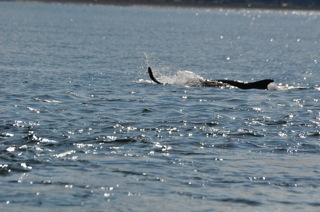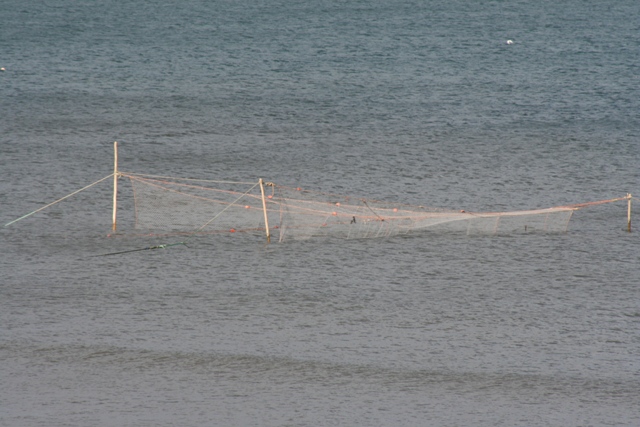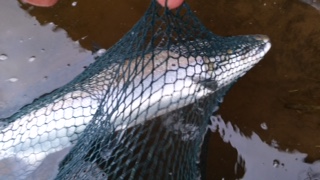THINKING ABOUT PREDATION: HOW DO WE DECIDE THE PRIORITIES?
Chapter One: the background.
I have been asked by visitors to FCW, and others involved with recreational salmon fishing, to explain where I think we are on the issue of predation. Whether you are in a boat on the Tay, or on the banks of the South Esk, you only have to observe for a short while before you have evidence of predation before your eyes. Most often in fresh water it will be fish-eating birds, but you might also see mink, otters, or the occasional seal, all of which will most probably be feasting on salmon and sea trout parr, and in the spring on their smolts, as they migrate towards the sea.
You might then logically say to your visiting angler, “terrible, isn’t it, that we allow this to go on. We should be culling these predators to conserve our salmon stocks”.
Predation by dolphins in the Moray Firth:
The beleaguered Atlantic salmon is prey throughout its life: if it isn’t a goosander or cormorant that gobbles up precious smolts in the river, it might be a large trout or pike in the lower river, or in the estuary or inshore a bass or gilt-head bream. Even after running the gauntlet of the river, another phalanx of predators – seals, pisciverous sea birds, porpoises, dolphins, and as yet unidentified invading species, to list just a few of the potential culprits.
So there you have it. We think we already know which species of UK’s indigenous animals are killing our salmon. And these predators are being supplemented by new arrivals as sea temperatures rise. Should we put a stop to this constant attrition by trying to exterminate more of them than we do at present? If we were successful, our salmon and sea trout could migrate with less prospect of being eaten. Is that the way forward?
I know that most people will say, “what a stupid question! Of course I don’t want to kill them all. I want to see a balance in the way we manage our wildlife”. Good, that is a really sensible answer, as any grouse moor manager and GWCT will tell you; but how do we decide what that “balance” should be? One person’s balance (the salmon angler) is another person’s slaughter of innocent wildlife (the RSPB). So, who is to decide the proportions of predators and prey that make for that balanced management approach?
Possibly the most damaging predation of all: coastal mixed stocks netting near Montrose
It is reasonable to assume that people who want to conserve stocks of wild salmon and sea trout want to see a reduction of predation. But we would also like to see wildlife beside and in our rivers – herons, mergansers and perhaps the occasional cormorant, a family of otters, along with other species such as dippers and kingfishers that pose a minimal threat to stocks. After all, all these animals are part of our national wildlife; they belong here just as much as salmon and sea trout do. I guess we anglers are looking for a sort of utopian balance, with free rising salmon rising in every pool, but without the burden of conscience from having to organise multi-species genocide to get it.
IS THE PREDATION PROBLEM REALLY ABOUT POLITICS?
You have the RSPB, IFAW and SPAG (Seal Protection Action Group), to name just three organisations that seek to protect the species they champion. In all cases their favoured species has some level of legal protection. For example, in the case of seals, the Marine Scotland Act allows only minimal licensed culling, and that is constantly under attack by those who want it reduced to zero. At present Scotland has about 200,000 Atlantic Grey seals and 20,000 common seals. Is that enough? Too few? Or too many? Who decides? Furry animals with appealing eyes will always win the political debate,
The same sort of thing applies to RSPB and protection of pisciverous birds, along with birds of prey, and with little thought of that elusive balance. Wise management, not just simplistic species protection is required if we are to get the balance right, and thereby start to rebuild our salmon and sea trout stocks. At present decisions on how many are killed are made a long way from the riverbank.
 Here is a predator, the iconic osprey, at Rescobie Loch, Forfar
Here is a predator, the iconic osprey, at Rescobie Loch, Forfar
‘MANAGEMENT’?: YOU MUST BE JOKING
The truth is that the various species-protection organisations are not concerned with management. Their interest is protection of their target species. Balance between the biological/environmental, economic, social and cultural aspects of human interactions with different species comes later, sometimes not at all. If ‘balance’ comes into their campaigns it is politically motivated as a sop to the public, or to support specific habitat requirements.
WHAT CAN WE – THE SALMON CONSERVATION COMMUNITY – DO ABOUT PREDATION?
Our resources are limited. Our communities are often divided in their views, and no one really knows where to start. One refrain from decision makers keeps returning, “Get your facts in order. Provide evidence. Wheel out the scientific data”. That means scientists. They are the people who can access the Facts, and politicians will only act on scientific facts. Science is important: in fact you can’t move without it!
WE MUST AVOID HYPOCRISY AT ALL COSTS But, and this is important, we must not become so obsessed with our concern for salmon that we exclude other species, some of which may deserve equal concern from their champions as we have for wild Atlantic salmon and sea trout. We must avoid hypocrisy at all costs. Indeed, there is no reason why we, the salmonids conservation sector, shouldn’t take the lead in defining what ‘balance’ means and how it might be achieved.
We anglers are ‘predators too, when we kill a fish
BEATING OUR HEADS AGAINST BRICK WALLS!
But what happens when we present the facts, as AST did conclusively with impacts of sea lice on west coast Scottish sea trout stocks, and still they won’t listen?
Do we give up trying to conserve sea trout (and wild salmon) on the west coast? Of course we don’t, but we know that in the present circumstances we are highly unlikely to win our arguments, even with the best data in the world. You don’t need to know much about Scottish political priorities to understand why…
In the next chapter I will start to set out the research and actions currently being undertaken to assess the threats to salmon and sea trout survival posed by predators. This is work in progress because it has to be in a rapidly changing natural environment with climate change and over exploitation of the seas, to name but two issues.
TA


